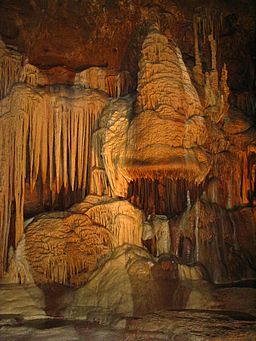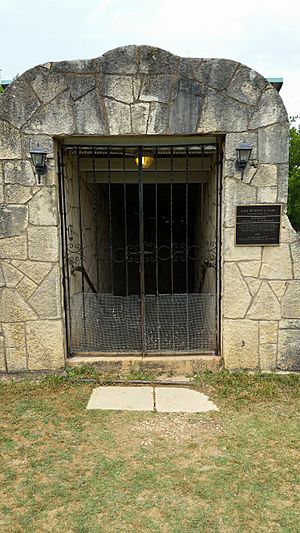Cave Without a Name facts for kids
Quick facts for kids Cave Without a Name |
|
|---|---|
 |
|
| Location | Kendall County, near Boerne, Texas |
| Geology | Limestone |
| Access | Show cave |
| Designated: | 2009 |

The Cave Without a Name is a cool underground place in the Texas Hill Country region of central Texas. It's a limestone cave, which means it formed in rock that dissolves easily. This cave is so special that it's been named a National Natural Landmark.
The cave is about 40 miles from downtown San Antonio and 10 miles northeast of Boerne, Texas. It has been open for public tours since 1939. It's a type of show cave, which means it's set up for visitors to explore safely.
Contents
History of the Cave
How the Cave Was Found
The cave has been open to the outside world for many thousands of years. We know this because scientists have found bones of ancient animals inside. People only really started noticing the cave in the early 1900s.
At first, a small farm animal got stuck in a tiny opening of the cave called a sinkhole. Later, in the 1920s, during a time called Prohibition (when making and selling alcohol was against the law), some people used the cave to make illegal drinks.
Rediscovery by Kids
The cave was mostly forgotten again until 1935. That's when three local farm children found the sinkhole once more. These kids are thought to be the first people to actually go inside the main parts of the cave.
How the Cave Got Its Name
After the children found the cave, the owner, Jim Horn, decided to open it to the public. The show cave officially opened in 1939. It got its unique name after a state-wide contest in 1940.
A young boy suggested that the cave "was too beautiful to have a name." He won a $250 prize for this idea! Later, a different owner tried to rename it "Century Caverns," but people in the area didn't like it. So, the name was changed back to Cave Without a Name.
A National Landmark
In February 2009, the Cave Without a Name was officially named a National Natural Landmark. This means it's a very important natural place that needs to be protected.
Exploring the Cave
Inside the Cave
To get into the cave, you walk down 126 steps. This takes you about 90 feet (27 meters) below the ground! The cave stays at a cool 66 degrees Fahrenheit (19 degrees Celsius) all year round.
The main part of the cave that visitors see is just over a quarter of a mile long. It has six large, well-lit rooms. These rooms are filled with amazing rock formations called speleothems.
Amazing Rock Formations
You'll see many different types of speleothems here. There are stalactites, which hang down from the ceiling like icicles. You'll also see stalagmites, which grow up from the floor.
Other cool formations include helictites, columns, and draperies. Columns form when a stalactite and a stalagmite meet. Draperies look like wavy curtains made of rock.
Hidden Passages and Water
Beyond the public areas, there's a huge network of caverns. These are connected to the underground parts of the Guadalupe River. In 1975, explorers mapped over 2.7 miles (4.3 kilometers) of these hidden passages. This made it the 7th longest cave in Texas at the time. Researchers from Texas State University are still mapping the cave today.
Concerts and Unique Features
The Queen's Throne room in the cave has amazing natural sound. Because of this, the cave hosts 8 to 12 concerts each year. Up to 200 people can attend these special events! You might hear singers, native American flute music, or even Tibetan singing bowls.
The cave also has other unique sights. There are 50-foot (15-meter) long rimstone dams, which are like small rock walls that hold back water in pools. You can also see 19-foot (5.8-meter) long draperies that guides call "Texas-sized cave bacon" because they look like giant strips of bacon. There's even a group of stalagmites that look like a nativity scene.
Cave Animals
In the winter, the cave becomes home to many eastern pipistrelle bats. They use the cave for hibernation, which is like a long winter sleep. They don't bother the tours at all.
Another special resident is a rare blind Texas salamander. It's called the Kendall County salamander. You can only find this type of salamander in the Cave Without a Name and one other nearby cave called Cascade Caverns.
Activities at the Cave
Besides cave tours, there's a lot to do on the 187-acre property. You can explore over a mile of hiking trails. There's also a scavenger hunt, gem panning, and places to have a picnic. Some activities might cost extra.
The gift shop has a large selection of rocks, stones, and fossils for sale. You can find beautiful Amethyst crystals, jewelry, and many different geodes. They even have a machine to cut geodes open so you can see the crystals inside!
See also
 In Spanish: Cave Without a Name para niños
In Spanish: Cave Without a Name para niños


